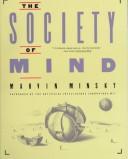The Society Of Mind by Marvin Minsky - ISBN 0671607405 - Simon & Schuster 1988
Motivation
Classical book by a founder of artificial intelligence. Watched the associated MIT class before and also visited CSAIL.
Pre-reading model
Draw a schema (using PmGraphViz or another solution) of the situation of the area in the studied domain before having read the book.
Reading
- 1 Prologue
- defining agents and agencies as constituents of the distributed mind
- Chapter 14.5 Brainstorming
- "However, when you are really stuck, you might as well tried wilder ways to find new ideas." (p143) similar principal to Seedea:Seedea/BackEnd
 and generalized Wikipedia:Simulated annealing
and generalized Wikipedia:Simulated annealing
- also discussed with Raphael regarding creativity, Saint-Maur flat July 2010
- several mentions of Piaget
- mention of Thomas Kuhn, see TheStructureOfScientificRevolutions
- the quote of Ernst Hans Gombrich regarding art can also be seen as an evolution of point of view, nearly an application of TreeOfKnowledge to art (see also Art)
- quoting Jakob von Uexkull
- Hofstadter on creativity
- definitions of concepts linking language, memory and specific cognitive usages (see the glossary)
- pronomes, close to a deictic function but from an agent perspective, temporary (see also K-lines)
- polynemes, permanent
- isonomes, a more functional role over agencies
- paranomes, parallely activated pronomes
- superpolynemes, superisonomes, superpronomes
- 30 Mental Models
See also
Overall remarks and questions
- if a society of mind is a set of interacting agents loosely coupled the ability to cooperate (or refuse to do so) is also required to have a proper understanding without having to rely on emergence
- important use of dialogues to question a presented viewpoint
- "society" can seen as an alternative to network with its interacting nodes, see also Cognition#HistoryOfDominantCognitiveModels for a more generalized view on popular models
- e.g. society of
- "agents", "minds", "ideas", "muscles, bones, and joints", "more", "mental agencies", "nearness relations between places", "different ways to learn", "many smaller mechanisms", "different kinds of processes"
- see also the glossary
- after about half of the book more and more terms being defined makes the comprehension harder
- micronemes/pronomes/polynemes/isonomes/frames/trans-frames
- what might seems for the reader like vague redefinitions is most likely for the author a fruitful and practical conceptual framework despite the cost of it not being broadly shared and used
- is there a software applications of the individual ideas and the overarching principle?
Synthesis
So in the end, it was about X and was based on Y.
Critics
Point A, B and C are debatable because of e, f and j.
Vocabulary
(:new_vocabulary_start:)
new_word
(:new_vocabulary_end:)
Post-reading model
Draw a schema (using PmGraphViz or another solution) of the situation of the area in the studied domain after having read the book. Link it to the pre-reading model and align the two to help easy comparison.
Categories
Back to the Menu
Other read books linking to the TheSocietyOfMind page :
Back to the Menu
 Fabien Benetou's PIM
Fabien Benetou's PIM









